Treatment of fusarium with chemical and folk remedies
One of the most dangerous fungal diseases affecting garden and indoor plants is fusarium. To cope with it, you need to recognize the symptoms and treat them on time. An equally important role is played by the prevention of fusarium: if you create the right conditions for plants, they can successfully resist fungal infection.
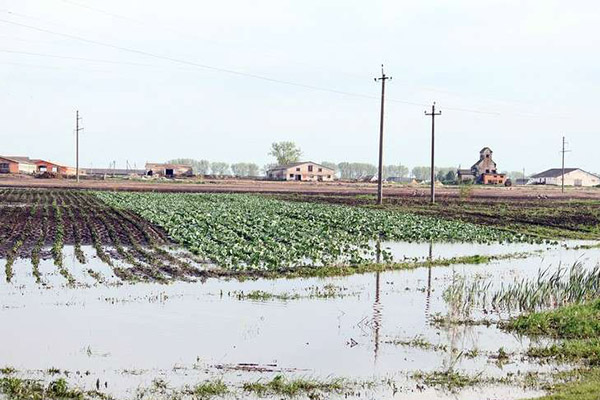
Risk factors
The fungus can attack plants at any stage of development. The infection enters the plant organism through the soil and places of damage (untreated sections, wounds).
As a result of the vital activity of the fungus, the work of the vascular system of the plant is disrupted. First, the roots are affected, and then the vegetative part.
The causative agent of fusarium enters the site through seeds and diseased seedlings. In the future, the infection remains in plant debris. Fungal spores are resistant to the effects of the external environment, safely tolerate wintering, and can spread by gusts of wind over considerable distances.
Fusarium outbreak is promoted by:
- sharp fluctuations in temperature and humidity;
- non-compliance with the landing pattern;
- acidic soil;
- imbalance of nutrients in the soil;
- too scanty or excessive watering;
- prolonged heat with high humidity.
The first time after infection, the fungus may not manifest itself in any way, but it is activated when favorable conditions occur and if agricultural technology is not followed. At first, the plant only slightly lags behind in growth, a little later the rapid development of Fusarium begins. If you do not take action, even an adult specimen can quickly die.
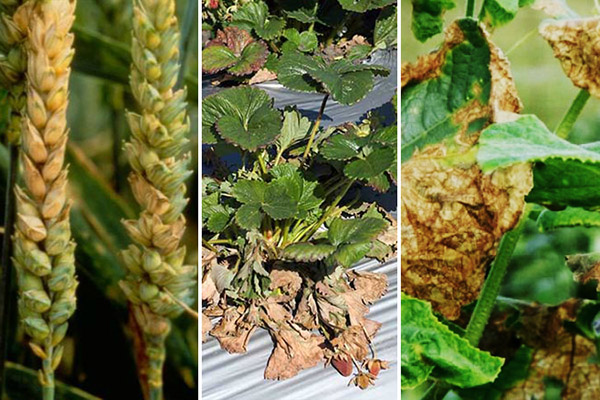
Symptoms
Today, great importance is attached to the correct description and treatment of the disease. The fact is that on each culture, fusarium manifests itself in different ways. An accurate diagnosis is impossible without an analysis of the symptoms that have appeared. Plants should be carefully examined at all stages of the growing season in order to timely identify signs of fungal infection.
In diseased plants, the following symptoms may appear:
- Potato contamination most often occurs during the flowering period. The leaves on the tops of the shoots become light, and on the sides they acquire a red border. They soon begin to fade. The lower part of the stems is affected, which is manifested by a change in color from green to brown. In wet weather, plaque may appear on diseased plants, the shoots rot. Sick bushes can dry out completely in just a few days.
- Tomatoes the infection enters through the lateral roots, then the fungus spreads to all tissues of the plant. The latent period of the disease can last from 1 to 4 weeks. Symptoms of fusarium appear during fruiting - curling and withering of the leaves at the tops of the shoots occurs. It seems that the plant lacks moisture. A little later, the leaves lose their color, becoming pale or yellow. On the cut of the stem, brownish lesions are visible.
- Fusarium cabbage may appear even at the seedling stage. The initial symptoms of the disease are yellowing and softening of the leaves. Later, dry brown spots appear on the affected areas. Soon the leaves begin to curl up and fall off. On the transverse section, tissue damage in the form of brown rings is noticeable. Plants infected at the initial stage of the growing season do not form rosette leaves.
- With fusarium cucumber symptoms can be seen at the stage of ovary formation. The disease affects plants both in the greenhouse and in the open field. At the tops of the shoots, the leaves begin to turn yellow, and the whips themselves dry out.The base of the stem becomes brown, begins to crack and rot. In humid weather, the affected areas become covered with a plaque containing spores.
- The defeat of garlic is caused by several types of Fusarium pathogens at once. The disease can manifest itself not only during growth, but also during storage. During the growing season, fusarium can be recognized by the appearance of brown stripes on the feathers and pink bloom in the axillary region. As the disease develops, the leaves turn yellow, rotting and death of the roots occurs. During storage, the infected heads become softened and covered with a yellowish or pink spore-bearing bloom.
- Fusarium of corn manifests itself at the stage of ear formation. In diseased plants, leaves and roots begin to dry, then a whitish-pink bloom appears on the cobs, the grains acquire a brown color, easily crumble.
Among leguminous crops, fusarium often affects lupine, and among cereals - barley and wheat. The disease manifests itself as a change in the coloration of the ear - it acquires a dark brown tint. Fields with these crops can be affected by fusarium everywhere, but areas with a humid climate are especially affected. The conidia of the fungus are carried by the wind to the surrounding crops, thereby rapidly increasing the affected area.
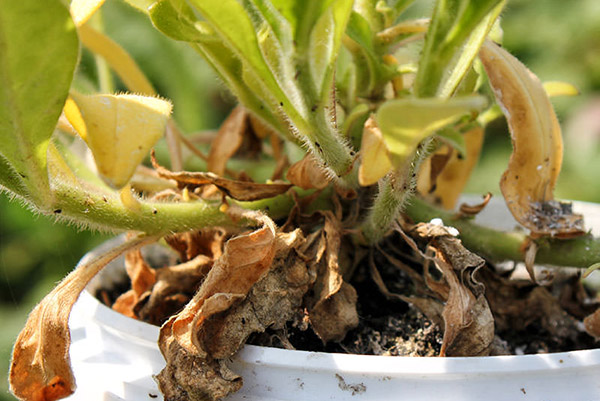
The infection does not bypass garden and home flowers. In collections of indoor plants, outbreaks of fusarium among orchids and violets are not uncommon. Yellow spots appear on the leaves, gradually the affected area increases, the tops of the stems wither. Over time, young shoots dry out, rotting areas appear on the plants. Diseased flowers can die in a short time.
Prevention of fusarium
It is impossible to get a full harvest from diseased plants. Preventive measures must be taken in advance to prevent an outbreak of fusarium. You should choose varieties resistant to disease for planting, follow the rules of crop rotation, disinfect seeds, buy only healthy seedlings, deacidify the soil with liming.
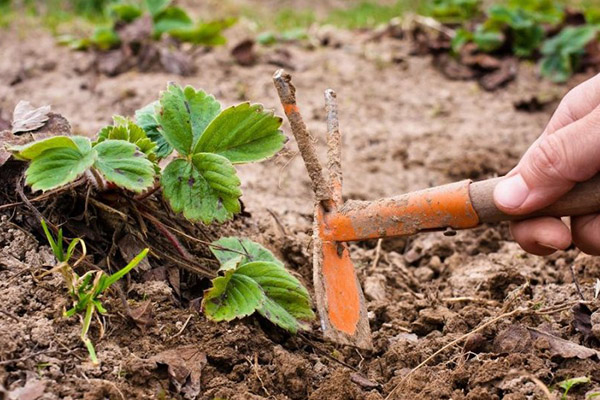
Planting care also plays an important role:
- The soil must be kept loose.
- Organic should be used sparingly.
- An excess of mineral fertilizers should be avoided.
- Plant beds need regular weeding.
- Plant residues must be destroyed in a timely manner or used for compost (if the plants were healthy).
- Since spores of the fungus can be carried by insects, you should protect the plantings from pests by regular spraying.
If, despite all efforts, symptoms of a fungal infection appear, it is imperative to fight it. For this, folk remedies and industrial fungicides are used.
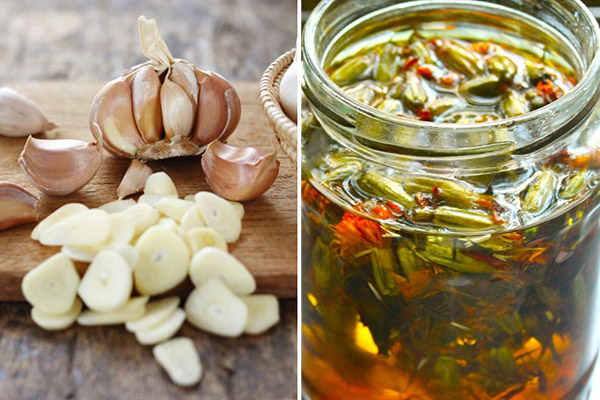
Treatment with folk remedies
For opponents of the use of chemicals in the fight against fusarium, folk remedies are suitable:
- Garlic and onions. Both plants have antifungal properties. You can prepare a composition for spraying from 2 guests of onion peels or 200 grams of chopped garlic. Raw materials are added to 1 liter of warm water and infused for 2-3 hours. The finished infusion is filtered and the volume is brought up to 10 liters with water. The composition should be sprayed on the leaves of the plant and shed the top layer of soil.
- Ash infusion - an effective remedy for fusarium. A liter can of ash powder is poured into 3 liters of boiling water and left overnight. In the morning, filter the infusion, bring the volume to 10 liters with clean water and add 40 g of shavings of laundry soap. The composition is thoroughly mixed and used for spraying. The procedure is best done in the evening.
- Marigold. Harvesting of raw materials is carried out during flowering. To prepare the infusion, use half a bucket of dried flowers. They are poured with 10 liters of warm water and insisted for 2 days. The finished infusion is filtered, and then used to treat diseased plants and the soil under them.
To enhance the effect, 30–40 drops of pharmacy iodine can be added to the finished composition or the water can be replaced with milk whey. It is necessary to carry out processing in dry weather.
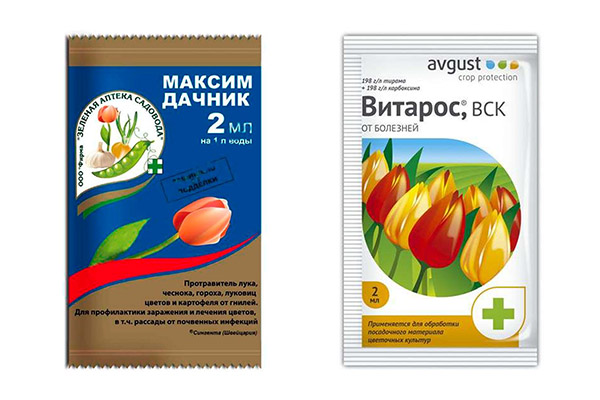
Application of fungicides
Fungicides must be used during the seed and bulb processing stage. In the future, they are used during the growing season of plants at the first signs of infection with fusarium.
Suitable preparations:
- "Vitaros". Fungicide is used to treat bulbs and rhizomes before planting and storage in order to dress the seeds. The working solution is prepared from 2 ml of the drug and 1 liter of water.
- "Maxim". The product is intended for preparing seeds and bulbs for planting. Before use, 4 ml of the product is dissolved in 2 liters of water. The duration of soaking depends on the planting material.
- Fundazol. It can be used to soak seeds and treat diseased plants. The drug acts systemically and has strong antifungal properties. The working solution is prepared from 10-15 g of the substance per 10 liters of water. It is used twice, with an interval of 1.5-2 weeks.
- "Trichodermin". An excellent biological fungicide replacing chemical preparations. It is used for soil cultivation, spraying plants, soaking planting material. Additionally enriches the earth with calcium and phosphorus. For watering and spraying, 50 g of the drug is dissolved in one liter of water, then filtered and the total volume is brought to 5 liters. In case of severe damage, up to 5 treatments per week are carried out.
- "Topaz". Penconazole-based broad-spectrum fungicide. Prevents germination of fungal spores, effective at any temperature. The solution for spraying is prepared from one ampoule of the drug with a volume of 2 ml and 5 liters of water. Re-processing is carried out after 2 weeks.
To avoid damage to the cultivated plants with fusarium, you should take care of them according to the rules, avoiding mistakes in agricultural technology. The disease is easier to prevent than to cure, so it is better to take care of the prevention of fungal infection in advance. In case of severe damage, diseased specimens are destroyed, the remaining plantings are treated with folk remedies or suitable preparations.
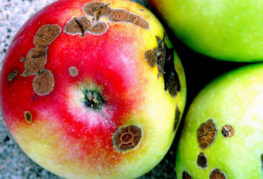


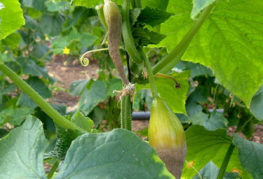
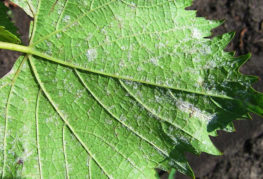
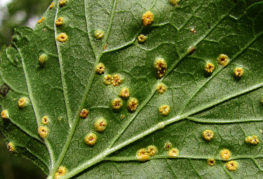
and will be published shortly.